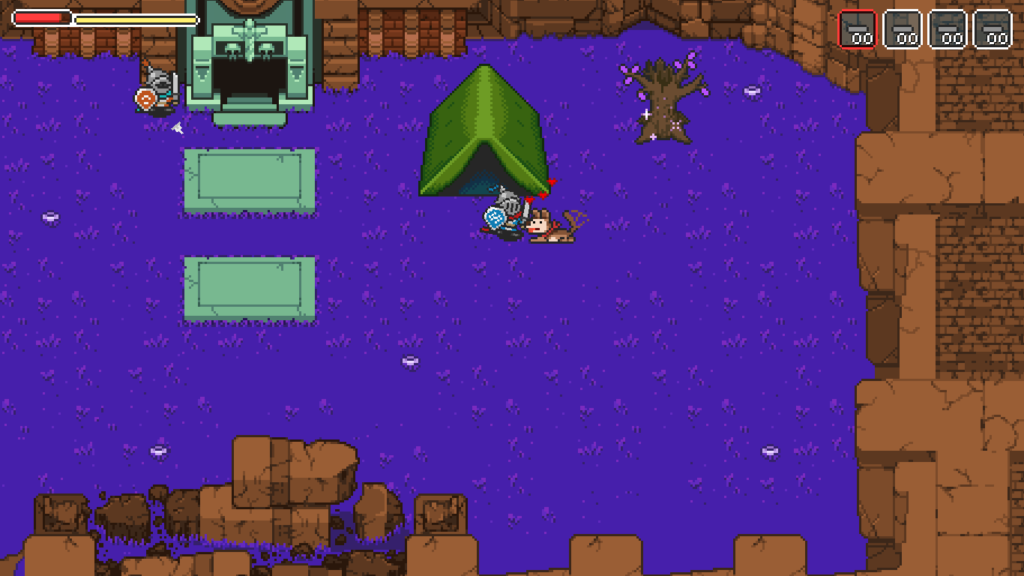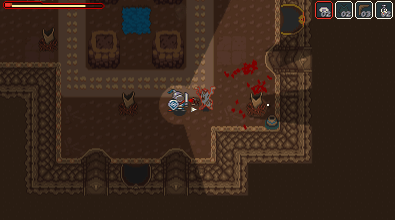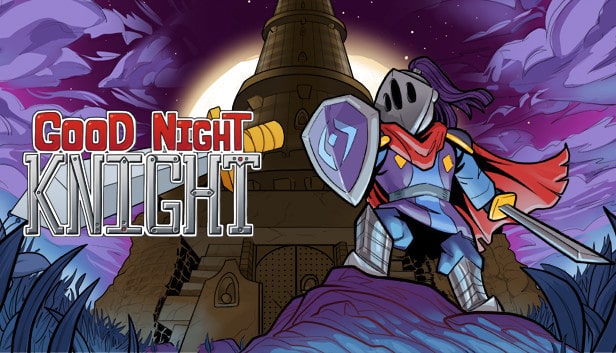Good night knight game review
Tale as old as time: the sage predicts the prophecy of a chosen one and summons upon a noble knight into a sacred mission to gather all the holy relics to bring redemption to the world. Except, Good Night, Knight is none of that crap. In this action RPG, you play as a “Holy Diver”, a quite literally fallen hero that crashes the party of a typical ordained champion initiation ceremony and steals the spotlight for himself.
Seeing this sudden nose-dive apparition as an act of divine providence, our easily distracted mentor figure and “professional quest giver” offers him the most important duties of all: fixing the tower’s elevator in order to liberate the people stuck in this god’s forsaken realm.
Disoriented and lacking any memories of his mysterious past, probably due to severe brain damage caused by the rough landing, our protagonist promptly takes this task without sparing a second thought.
Needless to say, none inspire seriousness nor credibility. The sage is possibly just a delusional senile crook, the former reluctant hero looks more like a spineless glorified gatekeeper, and the braveheart battalion protecting the land call themselves the “Useless Company”. Even the narrator is an unreliable one. In a world populated by weirdo NPCs, it’s hard to predict where the plot will take us. Everyone has the potential to be a wild card and from their wacky unexpected interactions, Good Night, Knight draws most of its charisma.

From the get-go, Good Night, Knight’s story is quite alluring and engaging. While it could be ever so slightly more elaborated, the writing has an amazing humorous flavor to it. I managed to chuckle a little bit every time a staple video game trope was made fun of. From wrongly naming your sidekick, to unlocking suspicious merchants, and ill-fated attempts to pet the dog. Nothing is sacred. Nothing is safe. The game is unapologetically whimsical, and its playfulness works fine as an homage to the genres it borrows inspiration from – and as a gleeful parody as well.
Although, in terms of narrative, after the ravishing presentation during the well-paced tutorial, things can get a little uneventful and the dramatic tension feels stagnated. I was left wanting more. But, fear not, the artifice the game uses to grab your attention is the addictive unstoppable dungeon crawler action. So, instead of the comic relief narrative – which is great, just too sparse for my taste, what makes this game stand from the rest is the myriad of great mechanics it has to offer.
There are just way too many things to keep track of, and I’m not sure I can explain it any better than the first-hand experience of playing the demo, but I’ll make an effort to summarize the best parts. Mainly, in Good Night, Knight, for the sake of fulfill his goals, the protagonist has to battle his way through the monster-infested rooms of the ominous spire that seems to have stolen his memories.

Traversing the maze-like structures that feature procedurally generated areas and slaying a handful of different types of enemies looks challenging initially. Fortunately, lots of treasure chests and NPCs are scattered throughout the rooms. Their rewards will quickly fill up your pockets with equipment that upgrade your skills and grant you new abilities.
It is worth noted that, despite marketing itself as a roguelike, Good Night, Knight is mostly quite “lite” when it comes to it. Every so often players will encounter checkpoints in the form of an elevator room that offers the opportunity to save progress. These areas serve as a gateway between the battlefield and your tent, where you can safely rest and restock.
As the name hints, sleeping is also a core mechanic in Good Night, Knight. Unlike other titles, it is very refreshing that you don’t simply get to rest and be magically fully restored as a result. Instead, you’ll have to make sure to collect enough monster drops, namely food (the red stuff) in exchange for fully replenish HP.
In the same way, there are two other drops: ingredients and provisions. Alongside food, this stuff can be found via loot drops, or by slicing pots, bushes, and grass. This triad of goodies can be used to refill your potions and repair consumable items. If you are feeling opulent, you can customize and even overload your crafting sites with some extra dose of these elements in exchange for greater effects. While overpriced, extravagant preparations can be helpful in overcoming hard areas.
Sleeping is also the opportunity to pass the experience gathered from slaying monsters into your equipment. Equipment is useful permanent items imbued with nifty powers, so it’s wise to grab as much as it is possible. Unfortunately, they are also heavy, and unless you get really experienced in using them, which decreases their burden value, you’ll have to handpick which one you are carrying and meticulously plan out your combinations. Or, you know, just embody the “Do you even lift, bro?” philosophy and train the hell out of them until they reach zero!
Curses is another feature that is among my faves but is possibly too much spoiler territory to cover them in depth. In the vaguest sense possible, they are essentially items that somehow cause a minor inconvenience or debuff in exchange for extra experience points. Though they are meant to be some sort of punishment, they usually add nice challenges with a tradeoff that usually payoffs. Can I just ask: why isn’t full curse mode a thing from the beginning?
In case you fall during combat, rest assured that death, while costly, is also forgiving. The game lets you keep a small fraction of the experience points, food, provisions and ingredients, and the entirety of materials, equipment, and items collected. So, death penalties don’t feel like a total bummer, since at least a little bit of progression is always guaranteed.

In terms of combat, you cannot just wildly swing your sword on an impetuous rampage through monster-packed rooms. Your techniques are heavily limited by your stamina bar. Attack, block, parry, backjump, dodge, run are actions that will quickly drain your energy pool if used immoderately. Thus, each action needs to be deliberate and meaningful in order to avoid getting fatigued and temporarily vulnerable.
Good Night, Knight’s of art war incentivizes resourcefulness and strategic thinking. In pursuance of outmaneuvering your opponents, you’ll have to wisely use everything at your disposal. Imaginably, mastering stealth tactics are fundamental to ensure long term survivability. In combat, being spotted too early is a recipe for disaster, and may cause a swarm of enemies to physically overwhelm you. On the other hand, working from the shadows allows you to work on field recognition and quietly taking down enemies one by one.
Stealth is also fundamental to hunt down monsters and harvest their parts for materials. Each monster has one unique drop, and collecting this loot will surely help you to craft better equipment. This is also a very effective way to take down great threats that are harder to outlast in direct combat. It’s a gimmicky move that requires a lot of cunning and is just that satisfying to pull out.

Unfortunately, bosses can be too much of a pain in the ass. Not only are they excruciatingly difficult, but once you finally beat them, some will just pull the Freeza stunt: “bro, this isn’t even my final form”, and predictably annihilate you from the face of the earth. Controls can be a little confusing and advanced combinations of commands are just too hard to pull off which may also add to the difficulty of the task.
At the end of the day, this aspect can be a little frustrating. I felt like my knight wasn’t actually enjoying a good night, but rather got stuck in the middle of sleep paralysis. A few tries on bosses’ levels can easily exhaust your resources, forcing you to backtrack and grind for more goods. Bosses can force you to get stuck on that loop for quite a while, artificially padding the runtime.
Still, I can see a lot of replay value in this game. Overall, I really enjoyed trying to stack up as many curses as I could bear, experimenting with different pieces of equipment, doing my best to master the combat techniques (I didn’t), and stealthily hunting down enemies for materials. Except when I was stuck on bosses, this didn’t felt like grinding at all.
I do wish for improvement on bosses’ level designs. Maybe tuning down the difficulty? Or adding some accessibility features that empower the player in any other way. But the game’s massive list of collectibles and exciting sneak-and-slash combat definitely kept me from dozing off.
In conclusion, Good Night, Knight is a dreamland for determined 2D adventure/action RPGs aficionados. The combination of elegant 16-bit art style, catchy epic chiptunes, and medieval fantasy themes feels like remixed nostalgia. Although, instead of a rusty daydream of the past, be prepared for a uniquely fresh mosaic of systems, including some top-notch roguelite mechanics paired with soulslike combat that guarantee a lot of replay value.
Yet, for its nightmarishly difficult bosses, demanding controls, and profuse grinding, it’s safe to assume this game isn’t suited to everyone’s taste. If you like hardcore challenges, silly humor, and great indie games, just give it a try! Good Night, Knight is launching in Early Access on Steam next week on February 16th, meanwhile, you can enjoy the free demo








